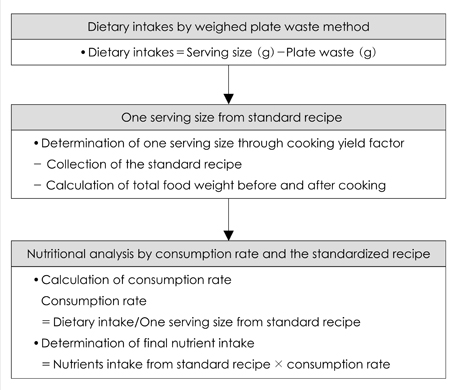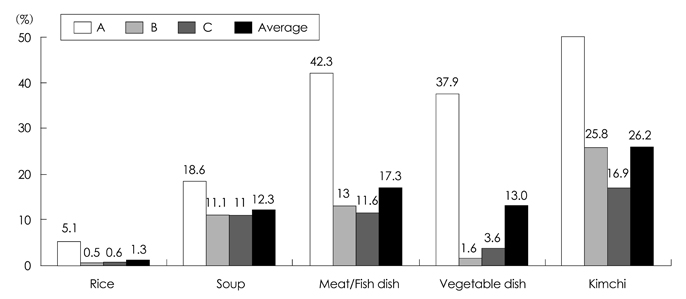Korean J Nutr.
2009 Oct;42(7):650-663. 10.4163/kjn.2009.42.7.650.
Assessment of Nutrient Intakes of Lunch Meals for the Aged Customers at the Elderly Care Facilities Through Measuring Cooking Yield Factor and the Weighed Plate Waste
- Affiliations
-
- 1Department of Food Science and Nutrition, College of Natural Science, Dankook University, Youngin 448-701, Korea. hjc10@dankook.ac.kr
- 2Research Institute of Food and Nutritional Science, Yonsei University, Seoul 120-749, Korea.
- 3Department of Foodservice Management, College of Hotel and Tourism Management, Kyunghee University, Seoul 130-701, Korea.
- KMID: 2267344
- DOI: http://doi.org/10.4163/kjn.2009.42.7.650
Abstract
- The purposes of this study were to investigate one portion size of menus served and to evaluate nutrient intake of lunch at three elderly care facility food services located in Seoul. A weighed plate method was employed to measure plate wastes and consumption of the menus served. Yield factors were calculated from cooking experiments based on standardized recipes, and were used to evaluate nutrient intake. One hundred elderly participated in this study for measuring plate waste and were asked to complete questionnaire. Nutrient analyses for the served and consumed meal were performed using CAN program. The yield factors of rice dishes after cooking are 2.4 regardless of rice dish types, 1.58 for thick soups, 0.60 to 0.70 for meat dishes, and 1.0 to 1.25 branched vegetable. Average consumption quantity of dishes were 235.97 g for rice, 248.53 g for soup, 72.83 g for meat dishes, 39.80 g for vegetables and 28.36 g for Kimchi. On average the food waste rate is 14.0%, indicating the second highest plate waste percentage of Kimchi (26.2%), and meat/fish dish (17.3%). The evaluation results of NAR (Nutrition Adequacy Ratio) showed that iron (0.12), calcium (0.64), riboflavin (0.80), and folic acid (0.97) were less than 1.0 in both male and female elderly groups, indicating significant differences of NAR among three facilities. Compared to the 1/3 Dietary Reference Intake (DRIs) for the elderly groups, nutrient intake analysis demonstrated that calcium (100%) and iron (100%), followed by riboflavin, vitamin A, and Vitamin B6 did not met of the 1/3 EAR (Estimated Average Requirement). For the nutritious meal management, a professional dietitian should be placed at the elderly care center to develop standardized recipes in consideration of yield factors and the elderly's health and nutrition status.
MeSH Terms
Figure
Reference
-
1. Article 36, Item 8974. The Elderly Welfare Act. 2008.2. Chang HJ. Strategies for the improvement of customer satisfaction on foodservice through identifying the foodservice quality factors in senior care facilities. Korean J Community Nutr. 2008. 13(1):69–79.3. 2008 Current situation of welfare facilities for the Elderly. Ministry for Health, Welfare and Family Affairs. 2009. Accessed March 29. Available from: http://www.mw.go.kr.4. Yi NY, Kwak TK. Nutrient intake determined by school lunch plate waste and by self-reported food consumption of selected high school students in Seoul. J Korean Dietetic Assoc. 2008. 14(1):1–12.5. Han KH, Choi MS, Park JS. Nutritional risk and its related factors evaluated by the mini nutritional assessment for the elderly who are meal service participants. Korean J Nutr. 2004. 37(8):675–687.6. The Korean Dietetic Association. Manual for Foodservice Operation. 2007. Seoul: KDA;48.7. Chen MY, Min HS. Study on effective methods for reducing leftovers in the food service business and industry. Korean J Community Nutr. 2003. 5(1):92–99.8. Hong WS, Chang HJ. The relationship between food service satisfaction and plate wastes in elementary school students. Korean J Soc Food Cookery Sci. 2003. 19(3):390–391.9. Lee KE. Adolescents' nutrient intake determined by plate waste at school food services. Korean J Community Nutr. 2005. 14(4):484–492.10. Guthrie HA, Sheer JC. Validity of a dietary score for accessing nutrient adequacy. J Am Diet Assoc. 1981. 78(3):240–245.11. Hasen RG, Wyse BW. Expression of nutrient allowances per 1,000 kilocalories. J Am Diet Assoc. 1980. 76(3):223–227.
Article12. Gibson RS. Principles of nutritional assessment. 1990. New York: Oxford University Press.13. Kwak KS, Bae YJ, Kim MH. Nutritional status and dietary quality in the low-income elderly residing at home or in health care facilities. J Korean Dietetic Assoc. 2008. 14(4):337–350.14. Choi HM, Kim JH, Lee HJ, Kim CI, Song KH, Chang KJ, Min HS, Yim KS, Lee KS, Kim KW, Kim HS, Yoon EY. 21 Century Nutrition and Health Story. 2005. Seoul: Life Science Publishing Co.;94.15. Kwak EH, Lee JS, Lee HS, Kwon JS, Kwon IS. Macronutrient, mineral and vitamin intakes in elderly people in rural area of north Kyungppook province in South Korea. Korean J Nutr. 2003. 36(10):1052–1060.16. Yim JS. Nutrient intake assessment of Korean elderly living in Inje area, according to food group intake frequency. Korean J Food Culture. 2008. 23(6):779–792.17. Nichols PJ, Porter C, Hammond L, Arjmandi BH. Food intake may be determined by plate waste in a retirement living center. J Am Diet Assoc. 2002. 102(8):1142–1144.
Article18. Lee TS, Jang YM, Kim IB, Lee HY, Jang JH, Pack JH, Um SJ. Study on the nutrient contents of cooked foods: Comparisons between the values from food composition table and from chemical analysis. The Annual of KFDA. 1999. 3:46–59.19. Hwang MY. Yield factor of muchim for cooking [dissertation]. 2006. Seoul: Dankook University.20. Kim KH. Yield factor nutrient composition of various Bab [dissertation]. 2009. Yongin: Dankook University.21. Choi BS, Kwon SY, Seo JY, Lee IS, Lee HJ. Comparison of nutrient intake and meal service satisfaction of elderly at local community centers: free and reduced meal service charge. Korean J Community Nutr. 2005. 10(3):303–310.22. Han KH, Chai IS, Park JS, Choi MS, Chung SD. Evaluation of the menus of free meal service centers for home-bound elderly. Korean J Food Culture. 2002. 17(5):584–593.23. Yang EJ, Bang HM. Nutritional statue and health risks of low income elderly woman in Gwangju Area. Korean J Nutr. 2008. 41(1):65–76.24. Korea Health Industry Development Institute. The third Korea national health & nutrition examination survey, 2005-nutrition survey (I). 2006. Ministry of Health & Welfare, Korea Health Industry Development Institute;204–243.
- Full Text Links
- Actions
-
Cited
- CITED
-
- Close
- Share
- Similar articles
-
- Nutrient Intake Determined by School Lunch Plate Waste and by self-reported Food Consumption of Selected High School Students in Seoul
- Assessment of the nutritional value of the plate waste generated in School Foodservices in Kyungbuk Area
- Nutrition Management Examined by Plate Waste Measurement: A Comparison with Elementary Schools and Middle Schools in the Changwon Area
- An Evaluation of the Nutritional Quality of Packaged Meal(Dosirak) Feeding of Adolescent Males in Kangnung
- Comparison of nutrients and food intakes of young children according to lunch places: based on the fifth Korea National Health and Nutrition Examination Survey



